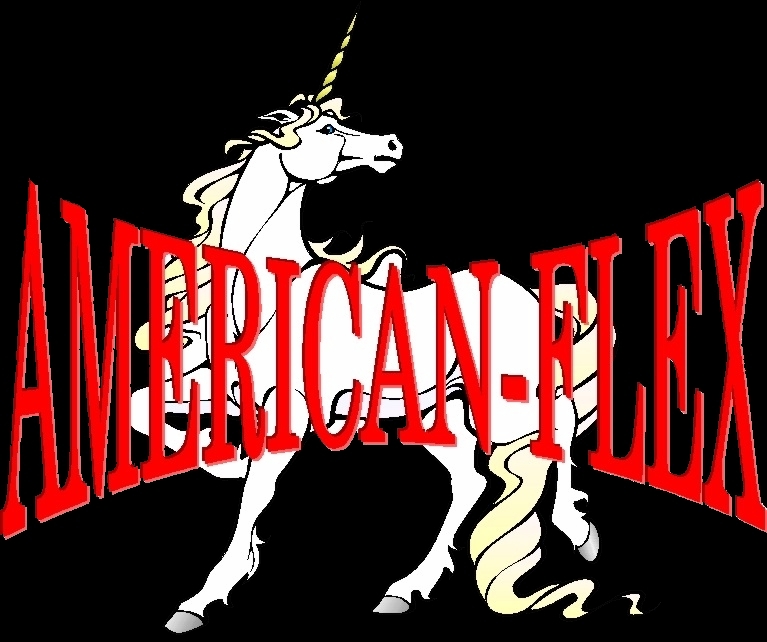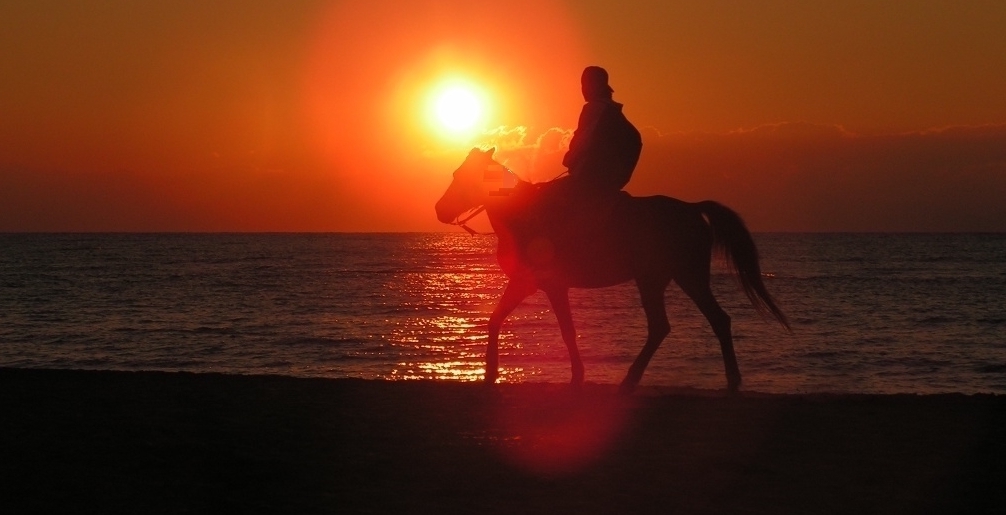Why a flexible panel-system ?
This question is easy to answer. Experts tell us that
approximately 80 to 90% – perhaps even more – of all horses have back
problems. Unqualified riders may cause some of the problem, but the
overwhelming majority are due to ill-fitting saddles. Some riders may think
this figure too high, but this is probably because many riders are completely
unaware of the problems their horses are suffering from. Saddle pressure is
still often equated with the appearance of white hair, swelling, edema and dry
spots.
By the
time these symptoms appear, saddle pressure limits may already have been
exceeded and irrevocable damage already been done to the horse’s tissue.
Saddle pressure begins much earlier. To recognize it (and to be willing to
recognize it), the rider must observe the horse and judge its actions and
reactions. A little prodding and probing of the horse’s body will give the
best chance of finding and localizing problems. This procedure of physical
palpation is far more advantageous than anything on the market. It is more
accurate and economical than any computer measurement. It is easy too. It is
hands on, right now, right there with your horse.
Some riders choose not to acknowledge these problems, for
if they did, they might have a troubled conscience – not to mention problems
with animal welfare legislation. But there are also many that recognize that
their horse has some sort of problem with its existing saddle. However,
instead of addressing the cause, they soothe their conscience with a variety
of products such as; wonder pads, gel pads, air-ride pads, layers of
sheepskin, shock absorbers, and many other forms of "fixes." Clearly the rider
is trying, even if the effort is halfhearted.
To find a real solution, one must deal with the root of the
problem. We begin with purely theoretical considerations about the effects of
an inflexible object, like a saddle on a horse’s very agile back. Logically,
how can we expect that a stiff object such as a saddle be able to fit a free
moving horses back ?
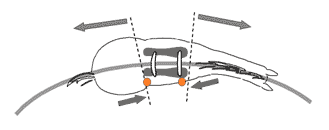 |
 |
| When your horse turns,
one side bevomes shorter and the other longer. A conventional saddle
cannot adapt to this movement. This results in increased pressure at
certain points. |
As your horse stands,
with its head up he has a slightly bent back, which a rigid saddle may
bridge, leaving a gap in the center of the back, puttinmg pressure on
the four corners of the saddle.
A horse with its head
lowered has a relatively straight spine. As with a horse that move down hill,
more pressure is place on the front edges of a conventional saddle. |
Therefore conventional saddles will
always produce certain pressure points-at some time -at some point, depending on
the basic shape of the saddletree. Fact.
Have you ever considered
fastening two wooden boards on your back ? Imagine this if you can and
after you have tied them nice and tight, just try to bend and move in
all directions. You will find that - no matter how wonderfully your
boards are cut and shaped - you will , no doubt, be very uncomfortable.
This is no different from what you are expecting from your horse. Worse
still, you pile weight onto your horse. Sit on your horse sometime
without a saddle and ride a short distance. Look down and notice how
the scapula rotates, how your horse´s whole back flexes and
chnages shape with each step. Now think back about those imaginary
boards.
Now take your present saddle ( without any extra pads to hide a true
fit ) and slip your hand right under the supporting surface, (for
example an the front, rear and center ) while having someone sitting in
the saddle. You will probably pinch your fingers and it will be
uncomfortable. The situation for your horse is exactly the same as for
your fingers ! What you feel is what your horse feels.
This realization should make it clear to everyone that something like a
saddle can never really work together with something very flexible like
a horse´s back.
But this is only the
movement-problem. Problems begin much earlier. They begin with the fact
that horse backs com in an infinitely number of shapes. With different
shoulder parts, different withers, different muscle-structure,
etc...This is why the saddle-industry has produced different
saddle-tree patterns, nearly all are ready-made-sizes. But will these
ready-made tree sizes really fit your horse ? Take a look how many
different horse types you can see in the pastures, regardless if they
are the same breed or not. Do you really believe a saddle-manufacturer
or saddle-tree-manufacturer could provide for all that variation ?
Truth is they can´t. They only offer a handfull of saddle-tree
patterns, at best, to choose from, and from that your horse must
conform. That is like saying, that you must only select a pair of shoes
from only four sizes. Really now....so are you so sure that your horse
will fit into that one tree-size ?
Now that we have established
the fundamental variation in horsebacks, we have the problem of how the
horse changes during movement. We still have another point: the same
horse is continiously changing over the course of its life. As the
result of growth, aging, training, feeding etc...its contours are
constantly evolving. This last point alone means you need to alter a
production saddle or acquire a new one six to twelve times over the
course of a horse´s life. A very costly matter indeed.
If all of this was not bad enough, another structural problem now
arises: the pressure load on the horse´s body resulting from the
rider´s weight. From medicine we know, that pressure of more than
105 grams per square-centimeter damages and can destroy organic tissue.
Let´s take a look for example at an English saddle: an average
English saddle has a supporting surface on the horse´s body af
approximately 440 square-centimeters. Now we put another 75 kg onto the
saddle - the rider. This gives us a load of 170 grams per
square-centimeter. Acceleration, gravitation etc. may at least double
this value during movement, producing a load of 340g /cm².
Let´s repeat this sample calculation with a western saddle. An average western saddle has a supporting surface of
620 cm². Let´s take our 75-kg-rider again, giving us a load of 121 g/cm², or 242 g/cm² during movement.
These values are valid for a contact over 100% of the supporting-area.
As we know however, the horse alters its shape during movement, making
this impossible to attain. Even if you add at least 1/4 to the load,
your calculations will be still be very much skewed in favor of the
saddle. Now think back to that 105-gram-limit once again.
So what is the solution to all theses problems ?
A flexible saddle-tree ?
For us, that was out of question since we did not see how it solved the
basic problem of the fit. At the same time - in our opinion - it is
important to keep the saddle stable. It should not ne like sitting on a
sponge. But that would be the logical consequence if the saddle were to
actually follow the horse´s movement. Another effect would be a
sagging of the tree, which would in turn concentrate the weight on
certain points. If we choose a somewhat harder tree, this "merging"
effect would vanish. A saddle tree is simply a large inert mass. The
next point was, that it would not have the supporting surface large
enough to meet our - or rather the horse´s - needs.
An adjustable saddle (bars and gullet) ? Well yes, not such a bad idea
but here again we would still be subject to the basic constraints
fitting it to the horse. Also any adjustments reaches a limt at some
point, not to mention that in this case the "normal" rider is always
dependent on assistance from others (saddle dealers). In addition, we
did not want something that is calibrated but something that changes
continuously. First because there are almost infinite variations among
horses, but also because these variations are gradual and not divided
into standardized sizes. These comments also apply of course to these
interesting variations of "saddle systems" that work with individually
padding.
Custom-made saddles ( saddle-trees ) ? On the basic of all these
considerations we rejected the idea of custom-made saddles just from
the beginning. Even a custom-made saddle can only in the best-case
scenario fit the horse 100%,....only in a standing position....without
movement....and only with respect to the horse´s present state.
A
treeless saddle ? Also not such a great idea. With this, there is
no need to take the traditional fit-parameters into account. But there
remains the problem of uneven, selective weight didtribution. And the
added problem of pressure load on the spiny processes, because a
treeless "saddle" cannot keep this area clear.
The solution is brilliant if
not quite simple
We
need a saddle in which the supporting surface is independent of the
saddfe-tree, automatically conforms to the greatest variety of horses,
is able to adapt to the horse during movement and its large enough to
distribute the weight over an area that is more than sufficient.
This was the beginning of
the American-Flex panel-system. We have a massive, inflexible tree as a
"chassis" to give the rider desired stability. Mounts are attached to
this tree to connect it to the panels. These mounts are shaped to allow
the panel to move in all three dimensions ( up, down, side-to-side ) -
independently of the tree ! In order to guarantee that the weight is
distributed over the whole panel, we have choosen a material that is
very smooth and flexible. At the same time, it is strong enough to
distribute the force over the entire surface. This was very important
to us, bevause only in this way will it work as a whole. Of course,
there are many saddles "out there" that resemble our system, where the
panels give way in the front and behind, but they are not really able
to actually distribute the weight. All other saddles - whether flexible
or traditional - have one thing in common: you ride these saddles on
the bars of the saddle tree, which is the source of the problems.
By the way: our development was so unique and new that we got an
international patent on it. Of course during the years there came many
others who tried to copy or just try to tell the customers they have
the same working system with their saddles. But you can be sure: the
origin American-Flex-panel-system with all its origin advantages is
only build by the inventor: by us, nowhere else.
Finally we would like to repeat the calculations we have just done of
the load per square centimeter on the horse´s back. Our saddles
have an average supporting area of 2088 cm². This means that
the calculations result in values of 35 or 79 g/cm². And since our
panels join in the movement, we don´t need to make any reductions
in the supporting surface. We are obviously far below the
105-gram-limit.
As you can see, it is quite easy to build a saddfle that is truly horse-friendly.
The construction and operation of the American-Flex system
In this section we present the "inner lives" of our panels in simple
sketched form. The ilustrtions are partially schematic, intend to
merely show the basic principles of our construction. We have omitted
representations of the padding, etc. The operational principal is based
on simple exploitation of the laws and physics and is essentially
quiete simple and logical. Nevertheless, the the application of these
simple physical laws to saddle construction has requiered many years of
intensive development work. The result is a unique saddle system, which
you will find exclusively under American-Flex saddles.
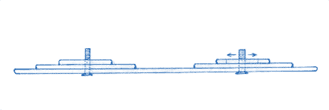 |
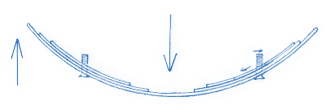 |
|
This is a cross section showing how our panel is constructed. You can see
that it has a multi-layered structure. This is very important, because only in
this way is it possible to distribute the load over the entire surface. A
single-layer panel, as found under other flexible panel saddles, is flexible
only in the ends. It looks nice, but it doesn’t distribute the rider’s weight.
You ride such saddles – like any other saddle – on the bars of the saddle
tree. If connected with joints, a single-layered panel could even have
disastrous effects. The joints could push through and cause uneven loads in
certain places. With our saddles, the tree and supporting surface are
independent. Although panel and tree form one unit, they are isolated from
each other. This means that the supporting surface on the horse can assume a
shape quite different from the shape of the tree.
|
When placed on the horse’s back and carrying the rider’s
weight, the panels follow the laws of mechanics and are forced to conform to
the horse’s contour. This will result
in flush contact over the entire surface
with even pressure distribution, and even during movement the panels adapt to
the constantly changing shape of the horse’s back. |
 |
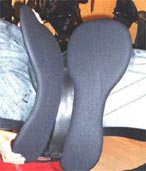 |
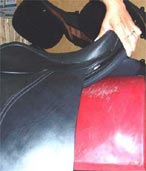 |
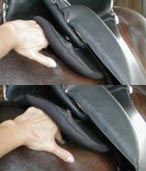 |
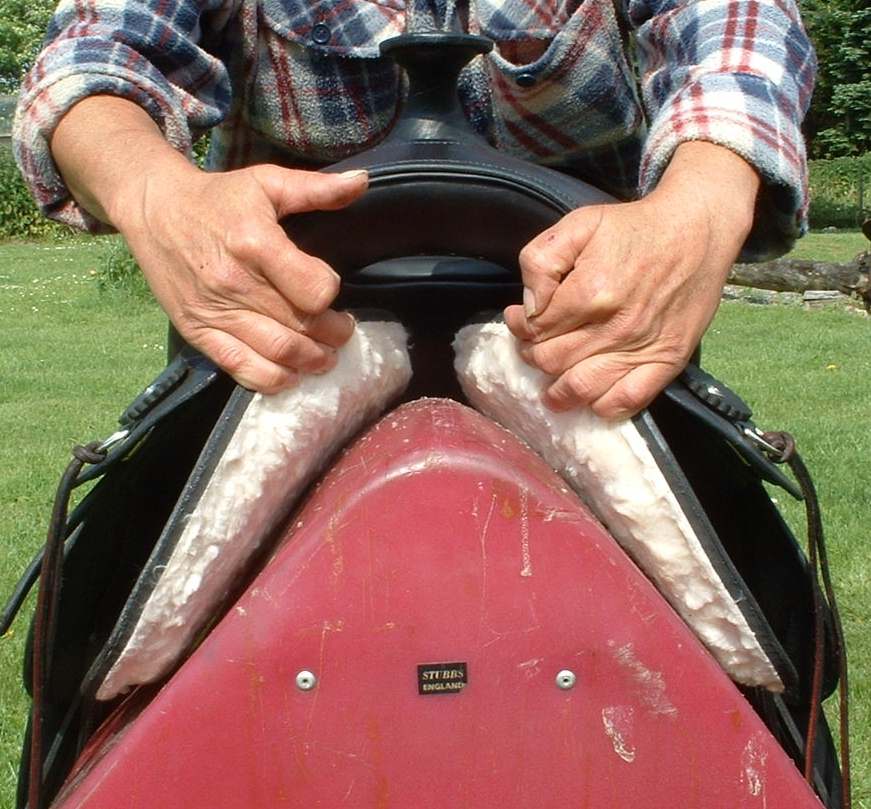 |
| Shown are the panels in initial condition, with no load.
Notice the huge weight bearing area. |
Above you see a simulated representation of
how the panel conforms to a horse’s bent back |
The panel ends are extremely pliable so as not to hinder
the horse’s lateral movements and turns...... |
...this also prevents interference with
the scapula... |
...also with the wither. |
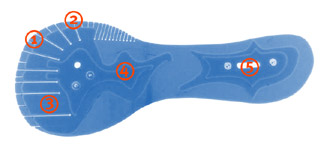 |
The special design of the panel
In the front area (1), the panel is built in the form
of slats. This permits an extra soft shoulder rotation. The slats extend as far
as the withers area (2), so horses with extremely wide withers never
feel too much pressure on this area.
The second layer of the panel (3) overlaps with the
slats from the first layer. This permits a transfer of the forces to the
subsequent layer and also a simultaneous distribution to the center of the
panel.
The remaining course (4) of the panel construction
guarantees an optimal distribution over the entire surface. The distribution
thus takes place in several "stages." In this way, we for example prevent
leverage on the panel from causing excess pressure on the opposite side for
horses with very wide shoulder areas. This gives us an even fluid distribution
of forces. Through the choice of different material strengths for each layer, we
also avoid the possibility of partially appearing pressure points.
We have developed a particular design for each layer in the
rear area (5) as well. This special shape guarantees an optimal weight
distribution over the entire panel – even in the middle.
|
Adjustable-System
For those horses for whom
this is still not enoigh, we have developed our "Adjustable System".
With this system, you can adjust the panel mounts for height at all for
corners. The system allows a height different of several centimeter.
With this system, you can optimally balance the saddle and yourself. It
also permits you to compensate for your horse´s anatomical
peculiarities to the milimeter. For example, horses with extremely
unusual confirmations or horses with one shoulder larger than the
other. This system will - no doubt - be needed only one horse in a one
hundred. Our panel by itself is already so efficent that it can
automatically compensate the most issues. Look at the "Adjustable
System" a little like the airbag in your car. When you really need it,
you´ll be happy it is there.
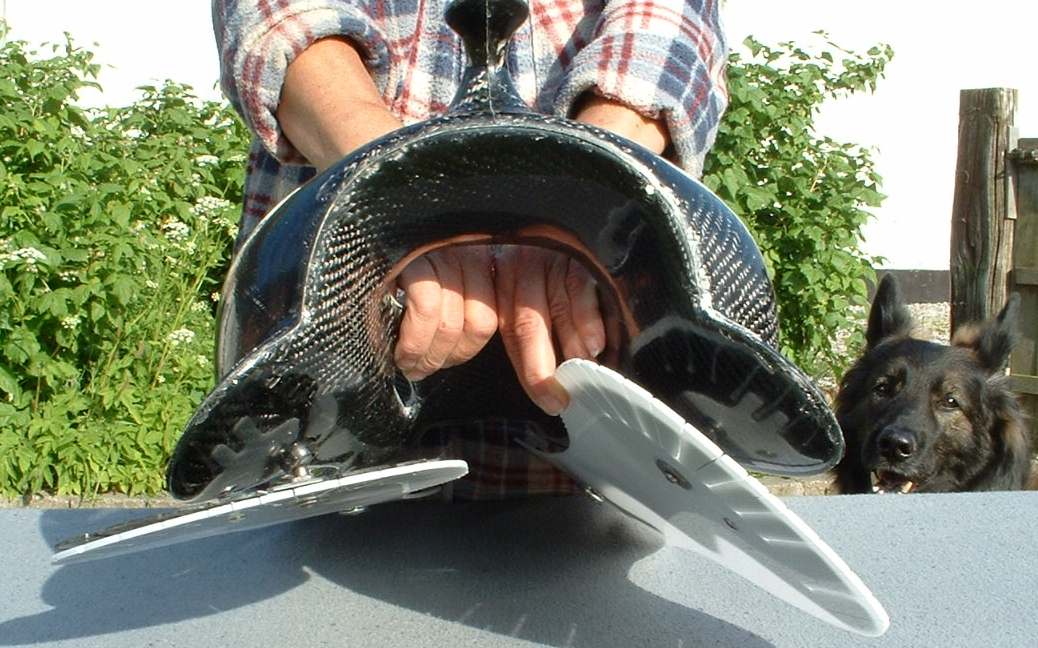 |
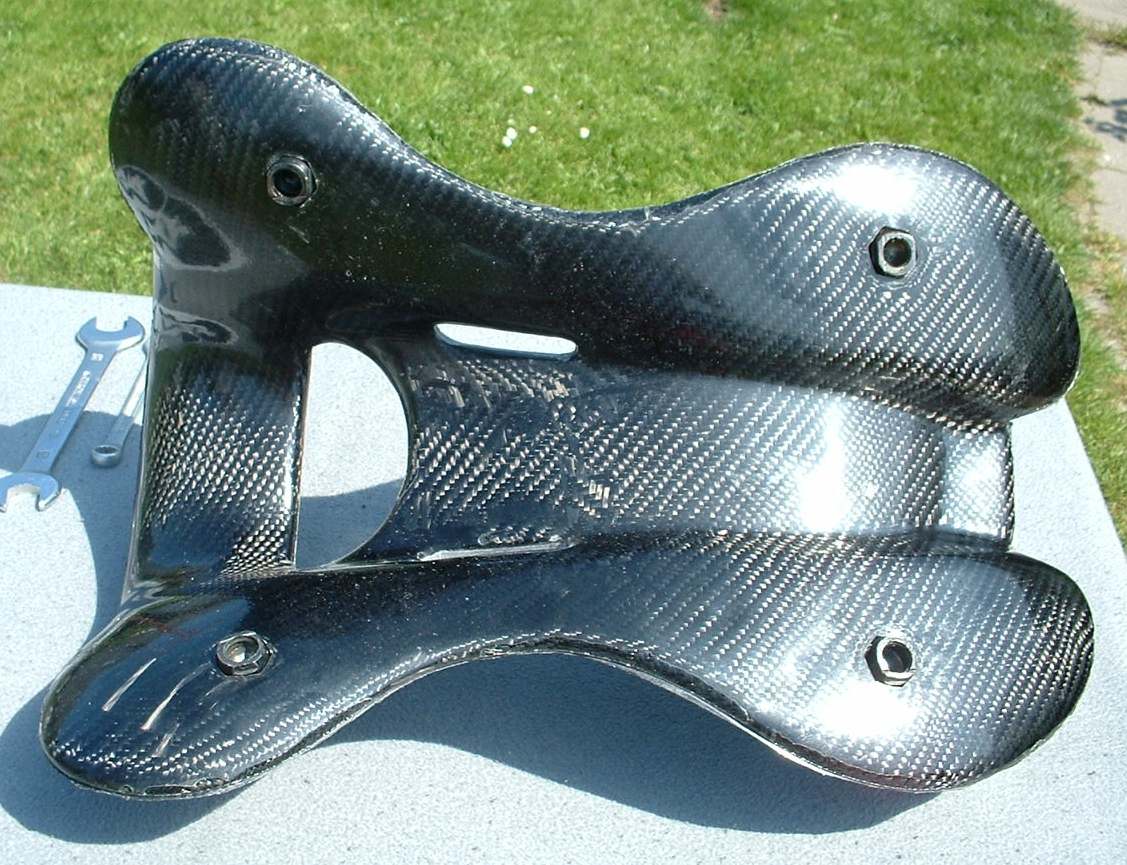 |
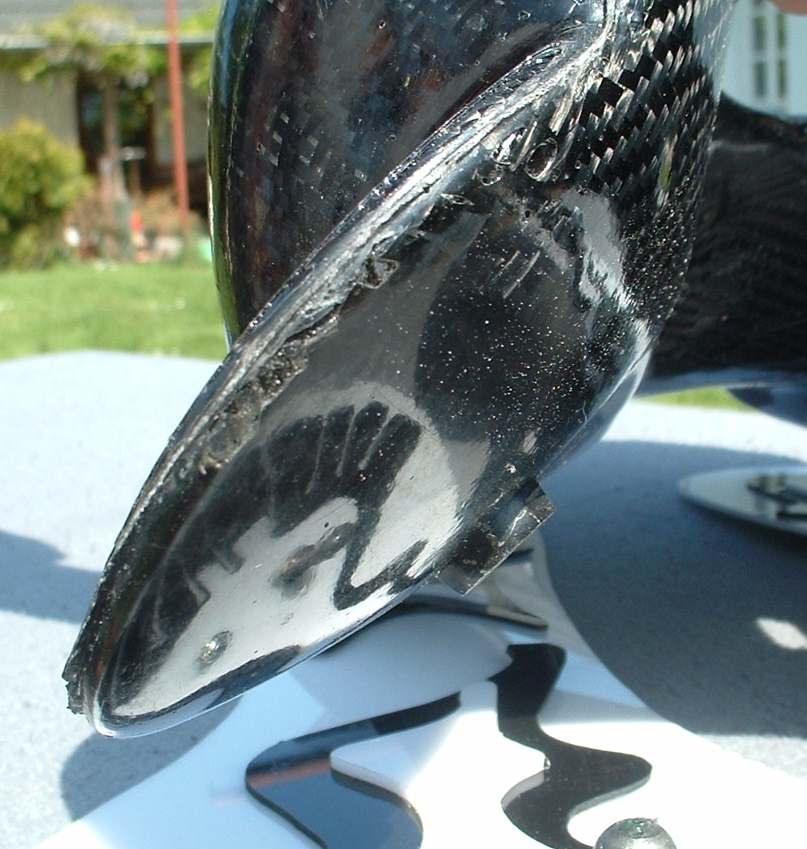 |
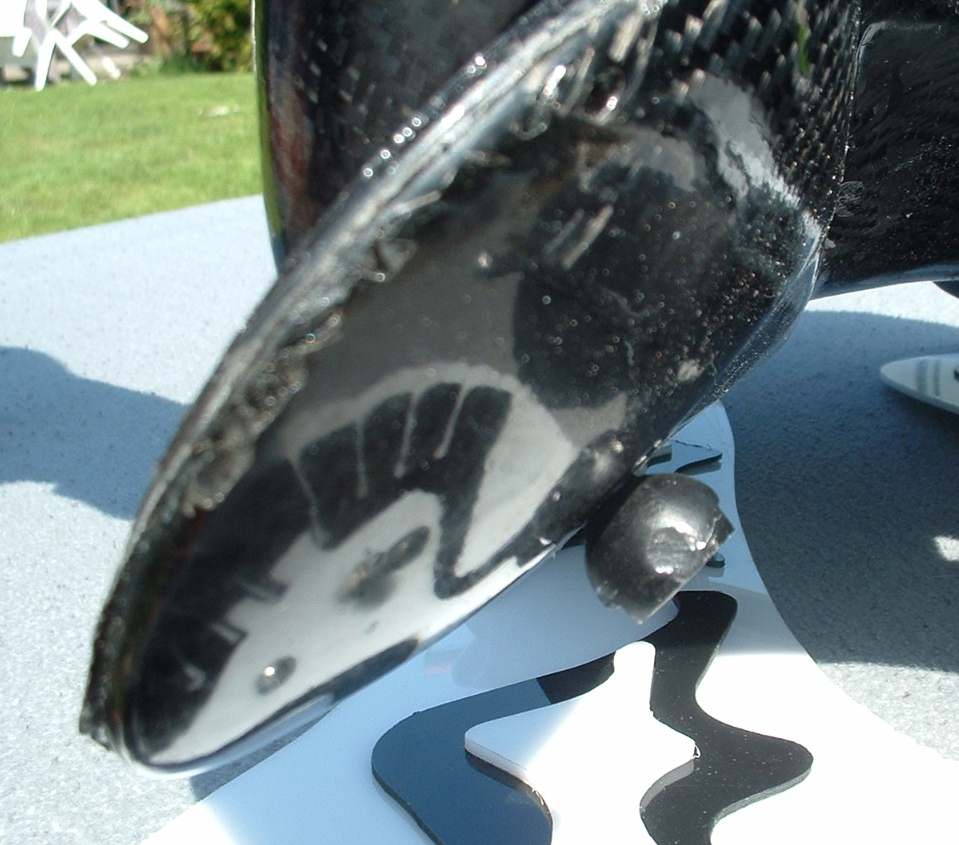 |
| The panel can take a different position and angle on each side. So it compensates many asymmetries by itself. |
In the saddle tree are four joints embedded, each one can be varied in height. |
This is a front-joint in "normal" adjusting.... |
...here it is adjusted a little bit out. |
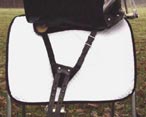 |
Adjustable American-Flex rigging.
Horses are not the same. Also girth-areas can be very different.
Therefore have we developed our adjustable rigging. It has the form of
an "Y", what gives your horse freedom at the front-leg and - at the
same time - holds your saddle stable on the horse´s back. It is
adjustable in seconds to the individual girth-area of your horse.
|
|
